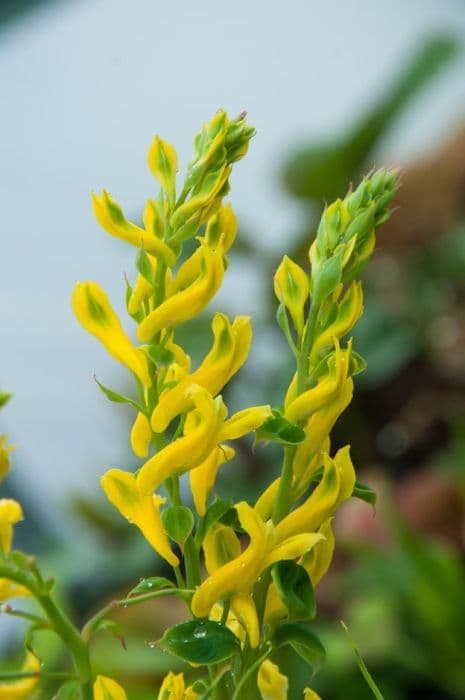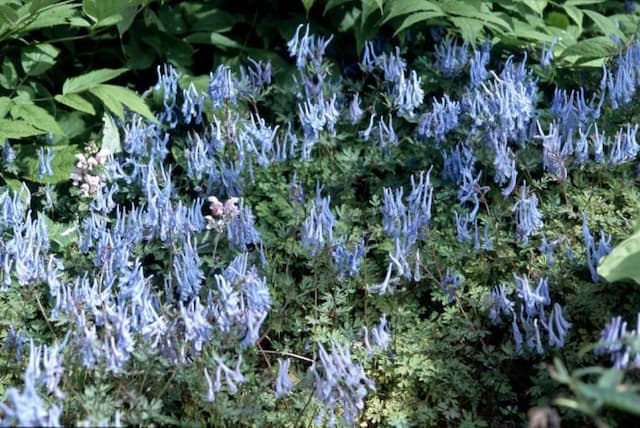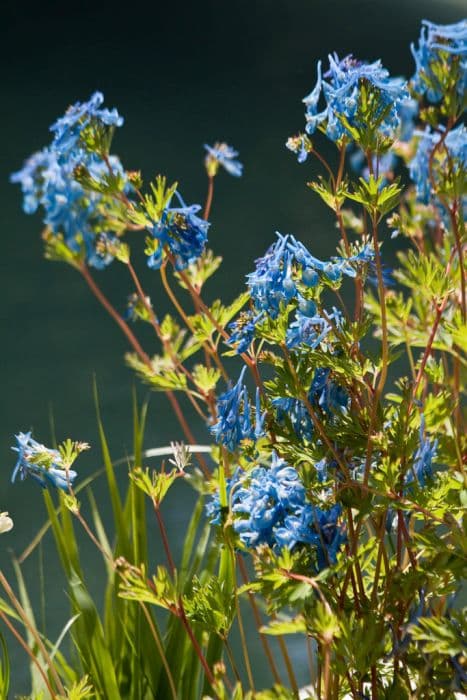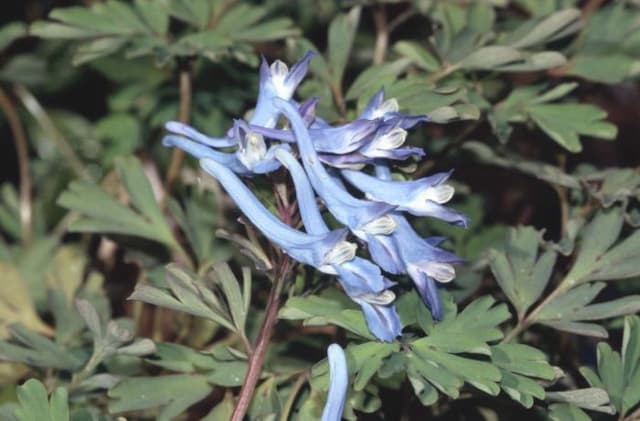Yellow horned poppy Glaucium flavum

ABOUT
The plant known as yellow horned poppy is a unique and striking species that is easily recognizable by its distinct features. This coastal wildflower stands out with its silver-grey foliage that almost seems to shimmer in the sunlight. The leaves are wavy-edged, exuding an almost silvery-blue hue that gives the plant a somewhat otherworldly charm. One of the most striking aspects of the yellow horned poppy are its flowers. The blooms are a vibrant yellow color, and they are large and bowl-shaped with four delicate petals that draw the eye. The flowers bloom generously throughout the summer months, creating a vivid splash against the cool-toned leaves. After the flowers have been pollinated, they give way to unusually long, curved seed pods. These pods have a horn-like appearance, hence the name "horned" poppy. The seed pods are a striking feature of the plant, adding to its unique appearance even after the blooming season has ended. While the specifics of the plant's size are not the focus here, it is worth noting that the architecture of the plant is such that it spreads out with a rosette of leaves close to the ground from where the flowering stems emerge. Overall, the yellow horned poppy is a fascinating plant, drawing attention with its glowing foliage, striking yellow flowers, and intriguing seed pods.
About this plant
 Names
NamesFamily
Papaveraceae.
Synonyms
Yellow Hornpoppy, Sea Poppy, Horned Poppy, Yellow Horned Poppy.
Common names
Chelidonium glaucium, Glaucium luteum, Glaucium corniculatum, Hornpoppy luteum, Horned poppy luteum, Yellow hornpoppy
 Toxicity
ToxicityTo humans
The plant Glaucium flavum, commonly known as yellow hornpoppy, contains a range of isoquinoline alkaloids that can be toxic to humans if ingested. These alkaloids can act on the central nervous system and may lead to symptoms such as nausea, vomiting, confusion, and dizziness. In severe cases, the toxicity can potentially result in respiratory failure and coma. As all parts of the plant contain these alkaloids, ingestion of any part of the yellow hornpoppy could result in poisoning and serious health consequences.
To pets
Glaucium flavum, commonly referred to as yellow hornpoppy, is toxic to pets due to the presence of isoquinoline alkaloids in all parts of the plant. These alkaloids can cause similar symptoms in pets as in humans, including vomiting, diarrhea, lethargy, and tremors. In serious cases, seizures and respiratory failure can occur. Consumption of any part of the yellow hornpoppy can be harmful to pets, and prompt veterinary attention is required if poisoning is suspected.
 Characteristics
CharacteristicsLife cycle
Biennials
Foliage type
Deciduous
Color of leaves
Silver-green
Flower color
Yellow
Height
1-2 feet (30-60 cm)
Spread
1-2 feet (30-60 cm)
Plant type
Herb
Hardiness zones
7
Native area
Mediterranean
Benefits
 General Benefits
General Benefits- Erosion Control: Glaucium flavum, commonly known as yellow hornpoppy, has extensive root systems that can help stabilize soil and prevent erosion.
- Drought Tolerance: Yellow hornpoppy is well adapted to dry conditions and can survive in environments where water is scarce, making it suitable for xeriscaping.
- Coastal Habitat Support: It thrives in coastal areas, providing essential habitat and food for various insects and wildlife that are adapted to these environments.
- Ornamental Value: With its distinctive yellow flowers, Glaucium flavum can add visual interest and beauty to gardens and landscapes.
- Agricultural Benefits: The presence of yellow hornpoppy can contribute to the overall health of agricultural ecosystems by supporting beneficial insects that pollinate crops or control pests.
- Soil Improvement: By growing in poor or disturbed soils, yellow hornpoppy can contribute to soil improvement over time through its organic matter and root structure.
- Seed Dispersal: The plant disperses seeds effectively, allowing for natural propagation and expansion of plant coverage in suitable areas.
- Ecological Diversity: By being a part of coastal and dune ecosystems, yellow hornpoppy increases the biodiversity of plant life and contributes to a balanced ecosystem.
 Medical Properties
Medical Properties- Analgesic: Glaucium flavum, commonly known as yellow hornpoppy, is sometimes reported to have analgesic properties, potentially aiding in pain relief.
- Antitussive: The plant has been used in traditional medicine for its potential to suppress coughs.
- Anti-inflammatory: Compounds present in yellow hornpoppy may help in reducing inflammation.
- Antimicrobial: Some studies suggest that extracts from Glaucium flavum might have antimicrobial effects against certain pathogens.
- Antioxidant: The plant is believed to have antioxidant properties due to the presence of secondary metabolites that may help in preventing oxidative stress.
 Air-purifying Qualities
Air-purifying QualitiesThis plant is not specifically known for air purifying qualities.
 Other Uses
Other Uses- Glaucium flavum, commonly known as Yellow Horned Poppy, has been traditionally used in the making of yellow dye, derived from its bright yellow flowers.
- The plant's unique visual appeal makes it a popular choice for ornamental purposes in rockeries and coastal gardens, where it adds a splash of color.
- The seed pods of Yellow Horned Poppy, with their interesting horn-like shape, are often dried and used in floral arrangements and craft projects.
- Apart from its beauty, its extensive root system helps to stabilize sandy soils, making it useful for erosion control in coastal areas.
- In some regions, the Yellow Horned Poppy is used as a tool in educational settings to teach about the adaptation of plants to seaside environments.
- The oil obtained from the seeds of the Yellow Horned Poppy has been used historically as lamp fuel before the advent of modern alternatives.
- The plants have been used as a natural pest deterrent; their bitter taste and potentially toxic compounds have been said to repel certain animal and insect pests.
- Artists sometimes use the unique silhouette of the Yellow Horned Poppy in various design and illustration projects to capture the essence of wild coastal landscapes.
- Its presence in coastal habitats provides shelter and microhabitats for small insects and wildlife, contributing to local biodiversity.
- In some traditional communities, the Yellow Horned Poppy has been used to mark the boundaries of properties due to its distinctive and robust nature.
Interesting Facts
 Feng Shui
Feng ShuiThe Horned Poppy is not used in Feng Shui practice.
 Zodiac Sign Compitability
Zodiac Sign CompitabilityThe Horned Poppy is not used in astrology practice.
 Plant Symbolism
Plant Symbolism- Rarity: Glaucium flavum, commonly known as "Horned Poppy," isn't a plant that one finds commonly in cultivated gardens, so it symbolizes something rare or unique.
- Coastal resilience: As a plant that thrives in coastal areas, the Horned Poppy represents the ability to withstand harsh conditions and symbolizes resilience and toughness.
- Beauty in adversity: The Horned Poppy blooms in areas that are typically harsh and salty, which can symbolize finding beauty in difficult circumstances or environments.
- Isolation: Since this plant often grows in less populated, sandy coastal areas, it can symbolize solitude or isolation.
 Water
WaterFor the Horned Poppy (Glaucium flavum), watering should be done carefully to maintain moist soil without waterlogging. During the growing season, water the plant thoroughly once a week with about 1 to 1.5 gallons of water, depending on the size of the plant and the environmental conditions. In the hot summer months, you may need to water twice a week. During the winter dormancy period, reduce watering to once every two to three weeks, ensuring the soil doesn’t completely dry out. It’s important to allow the top inch of soil to dry out between waterings to prevent root rot.
 Light
LightThe Horned Poppy thrives in full sunlight conditions. Place the plant in a location where it can receive at least 6 to 8 hours of direct sunlight daily. The plant is adapted to coastal environments and prefers a spot with bright and unfiltered light. Avoid locations with prolonged shade as it can hinder the plant's growth and flowering.
 Temperature
TemperatureThe Horned Poppy can withstand a range of temperatures but performs best in moderate conditions. It prefers temperatures between 50°F and 75°F and can survive short dips just below freezing, but prolonged exposure to temperatures below 30°F can be detrimental. Ensure to protect the plant from frost to prevent damage to foliage and flowers.
 Pruning
PruningPruning Horned Poppy plants helps to maintain their shape and encourage bushier growth. Light pruning can be done in the spring to remove any damaged or dead foliage from the winter season. It’s also advisable to deadhead spent blooms to encourage further flowering throughout the season. The best time for significant pruning is after the plant has flowered, usually in the late summer or fall.
 Cleaning
CleaningAs needed
 Soil
SoilHorned poppy thrives in well-draining soil with a mix of sand, loam, and a small amount of organic matter. The ideal pH for this plant ranges from neutral to slightly alkaline (7.0-8.0). To prepare the best soil mix, combine two parts sand, one part loam, and a handful of compost or aged manure for nutrients.
 Repotting
RepottingHorned poppy is typically not repotted often as it is a short-lived perennial and prefers to be left undisturbed. It may only need repotting if it outgrows its container, which is usually every few years, or if the soil becomes depleted or compacted.
 Humidity & Misting
Humidity & MistingHorned poppy prefers a drier environment, so the best humidity level is on the lower end. It does not require high humidity and can thrive in typical outdoor conditions where humidity is not artificially maintained.
 Suitable locations
Suitable locationsIndoor
Provide full sun and well-draining soil.
Outdoor
Plant in full sun, well-draining sandy soil.
Hardiness zone
7-10 USDA
 Life cycle
Life cycleGlaucium flavum, commonly known as yellow horned poppy, begins its life cycle as a seed, which germinates in spring to early summer in well-drained soil with full sun exposure. It develops a deep taproot and a rosette of wavy, bluish-green leaves during the vegetative stage. In its second year, the plant produces tall flowering stalks with bright yellow, poppy-like flowers from late spring to late summer, which are pollinated by insects. Following pollination, elongated, curved seed pods (resembling horns, hence the name) develop, containing numerous tiny seeds that are dispersed by wind or water. The yellow horned poppy is a biennial or short-lived perennial, completing its life cycle in two to four years, after which it dies. However, the plant can self-seed effectively, leading to new plants germinating nearby if conditions are favorable.
 Propogation
PropogationPropogation time
Spring to early summer
For the Horned Poppy, or Glaucium flavum, the most popular method of propagation is by seed. The best time to sow these seeds is in the spring, preferably after the danger of frost has passed. Seeds should be scattered on the surface of a well-draining soil mix and lightly covered with a thin layer of soil or vermiculite to maintain humidity during germination. It's important to keep the soil moist, but not waterlogged, and to place the sowing container in a bright area with indirect sunlight. Germination usually takes 14-28 days at temperatures around 60-65 degrees Fahrenheit (15-18 degrees Celsius). Once seedlings are large enough to handle, they can be transplanted to individual pots or their final positions in the garden where they will flourish in full sun and well-drained soil.









